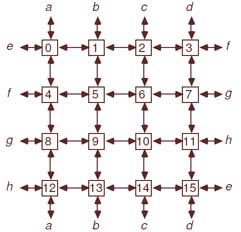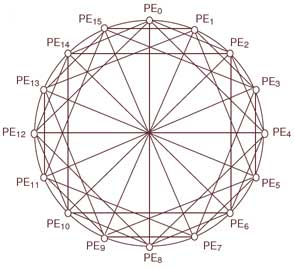CSC/ECE 506 Fall 2007/wiki4 8 xk
Jump to navigation
Jump to search
Overview
Interconnection networks discussed in Parallel Computer Architecture lectures are somewhat simplified or idealized; in real parallel computers, network topologies often comprise modifications or amalgams of these basic structures. This article will examine some basic interconnection topologies and then describe the "realistic" topologies implemented in a few modern systems.
Basic topologies
- Ring networks, as the name suggests, are organized into a ring structure, with each processing element P connected to its neighbors P - 1 and P + 1.

- Mesh networks form grid-like structures in which each processing element P is connected to nodes P - 1 and P + 1, as well as "skipping" several nodes ahead and behind (i.e. connections to P - 4 and P + 4 in a mesh network with four nodes to a row).
- Hypercube networks form cubes with log2 n nodes to a side, where n is the total number of nodes.

- Barrel shifters are similar to mesh networks with the addition of connections from each node to nodes 2<super>i</super> ahead and behind that node (where i is any integer). For instance, node P would have connections to nodes P + 1, P + 2, P + 4, P + 8, etc., as well as to P - 1, P - 2, P - 4, P - 8, etc.
Real-world implementations
Many modern supercomputers utilize proprietary interconnection schemes and therefore data on them are limited or difficult to find. The following list designates the interconnection network topologies used in various supercomputers for which such data are available.
- SGI Altix ICE 8200: Infiniband (switched fabric topology)
- Red Storm: Cray XT3 Interconnect (three-dimensional toroid)
- Blue Gene/L
- Three-dimensional toroid for inter-nodal peer-to-peer communication
- Collective (broadcast) network for one node to send messages to several other nodes simultaneously
- "Global barrier network" which performs a global OR operation over all nodes